Clash of Titans
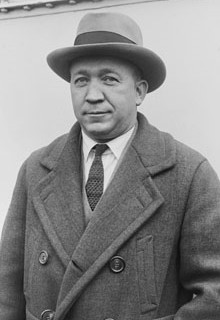
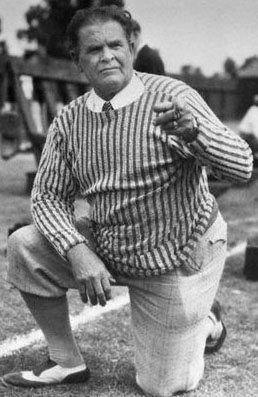
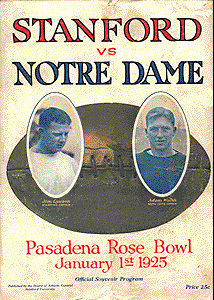
L-R: Knute Rockne, Glenn "Pop" Warner, 1925 Rose Bowl program
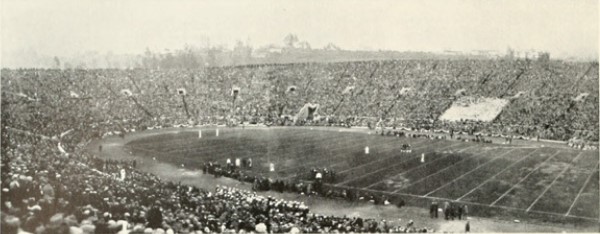
1925 Rose Bowl (Stanford University Quad Yearbook Class of 1926)

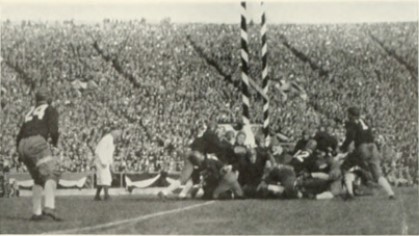
L: Ernie Nevers plunges through Notre Dame line.
R: Elmer Layden pushes over for Notre Dame touchdown.
(Stanford University Quad Yearbook Class of 1926)
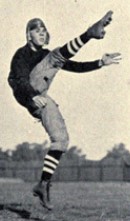
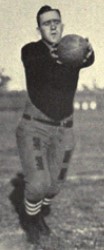

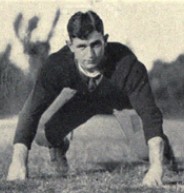
L-R: Norman Cleaveland, Murray Cuddeback, Ted Shipkey, Fred Solomon
Stanford University Quad Yearbook Class of 1925
Games featuring a future Hall of Fame coach on each sideline.
January 1, 1925: Rose Bowl - Notre Dame vs Stanford
Knute Rockne vs Glenn "Pop" Warner
As champions of the Pacific Coast Conference, 7-0-1 Stanford locked up the host spot in the Rose Bowl if the school administration voted to accept the invitation. A favorable vote would earn second-year Coach Glenn "Pop" Warner a bonus of $2,500.
The Rose Bowl at that time allowed the host team to choose its opponent for the big game. Warner selected the 9-0 Fighting Irish of Notre Dame coached by Knute Rockne.
The money and publicity to be gained by playing Notre Dame persuaded Stanford to accept the bid, and in early December the matchup was announced, provoking articles like this one in the Woodland (CA) Daily Democrat.
The two greatest football coaching systems in the United States will clash when Stanford and Notre Dame meet in the Rose Bowl at Pasadena New Year's Day. POWER – the grinding, crushing, irresistible offensive of "Pop" Warner's team will be pitted against the SPEED and PRECISION required in the famous Notre Dame shift of Knute Rockne.
The contest should bring out some of the best football ever seen on the Pacific Coast. Although the colorful Catholic aggregation relies mainly on speed, it is by no means without punch. On the other hand, that the Cards do not have to bank entirely on straight football to gain ground was proved in the California-Stanford game when Warner's team scored two touchdowns in the last five minutes of play on forward passes. ...
Neither team has been defeated and the winner will have a strong claim on the football championship of the United States. Stanford's chances to take the South Benders into camp will depend largely on whether or not Ernie Nevers and Norman Cleaveland will be able to play. The former was kept out of the Big Game with a cracked ankle bone and Cleaveland was declared ineligible. Nevers' physician says that the big fullback will be in shape to perform, but Cleaveland's appeal was denied.
That write-up was typical of many that would follow in the weeks leading up to the game. It focused more on the coaches than the players. Warner had just completed his first season at Stanford after nine years at Pittsburgh and, most famously, eight years before that at Carlisle Indian School where he taught the immortal Jim Thorpe to play football.
Warner gathered a huge amount of information on Notre Dame's formations and tendencies and used it to prepare his defense. One San Francisco reporter wrote, "Never before did a coach have as much information about a team as has Warner. The intelligence section of the United States expeditionary force during the World war ... was a mere amateur compared to Warner's volunteer informants." Included in the info were dozens of photos of the Irish taken from the sidelines or from grandstand roofs. They showed the action right after the snap of the ball as plays and blocking schemes developed. Pop also got a detailed description of Notre Dame's offensive and defensive strategies from Princeton coach Bill Roper, who lost to the Irish in midseason.



L-R: Knute Rockne, Glenn "Pop" Warner, 1925 Rose Bowl program
Rockne decided to make Notre Dame's first trip to the West Coast a cross-country tour akin to the barnstorming baseball series that brought the stars to the people in that pretelevision age. He also packed a baggage car with Indiana water. That removed any worry about contaminents in the water in the stops along the way.
The Notre Dame contingent left South Bend by train a week before the game and traveled to New Orleans, a city with a large Catholic population. Rock put his charges through a vigorous workout that was open to the local folks.
The train then headed to Houston, where Rockne held a practice session open to the public. The cavalcade continued to Tucson AZ for four days of practice in weather similar to sunny California's. Slip Madigan, a teammate of the immortal George Gipp and the head coach at St. Mary's in California, traveled to Tucson to give his former coach a scouting report on Pop Warner's offense. Madigan's report focused on the all-around talents of Nevers, including a screen pass to Ernie that often caught defenses off-guard.
On New Year's Eve, the entourage rolled into Los Angeles, where thousands of admirers awaited. Rock kept the team under wraps that night to focus on the task at hand.
Featured Players: Notre Dame's Four Horsemen
Notre Dame's backfield become nationally famous thanks to the nickname given them by Grantland Rice in his New York Herald Tribune article on the Notre Dame-Army game of October 18, 1924.
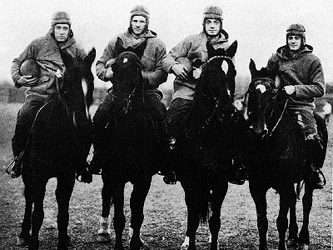
"The Four Horsemen of Notre Dame"
L-R: Jim Crowley, Elmer Layden, Don Miller, Harry Stuhldreher
This picture was taken right after the team arrived in South Bend from the Army game.
Outlined against a blue-gray October sky, the Four Horsemen rode again. In dramatic lore they are known as Famine, Pestilence, Destruction and Death. These are only aliases. Their real names are Stuhldreher, Miller, Crowley and Layden. They formed the crest of the South Bend cyclone before which another fighting Army football team was swept over the precipice at the Polo Grounds yesterday afternoon as 55,000 spectators peered down on the bewildering panorama spread on the green plain below.

"The Four Horsemen of Notre Dame"
L-R: Jim Crowley, Elmer Layden, Don Miller, Harry Stuhldreher
This picture was taken right after the team arrived in South Bend from the Army game.
The Four Horsemen entered Notre Dame together in the fall of 1921.
QB Harry Stuhldreher from Massillion OH displayed leadership qualities. He was intelligent and utterly fearless.
LHB Jim Crowley from Green Bay WI was nifty, although not exceptionally fast or shifty.
RHB Don Miller from Defiance OH had excellent speed.
FB Elmer Layden from Davenport IA could run the 100y dash in ten seconds and was an excellent punter. He was also the best defensive back of the four.
"Not so hot," was Coach Rockne's impression of them in their first practices as freshmen. But through hard work, they became "marvelously synchronized, its members complementing each other in temperament, physique, and instinctive pacing."In their three years leading to the Rose Bowl invitation, the Horsemen had sparked the Irish to 26 victories against only two losses and a tie. None of the losses came in 1924 season when Notre Dame finished 9-0 to earn a trip to Pasadena.
Featured Player: Stanford's Ernie Nevers
|
Ernie Nevers was born in 1903 in Willow River MN to parents who were immigrants from Canada. He grew up in Superior WI where he attended Superior Central High School. Bigger than most of the boys his age, he played tackle, excelling on defense. He was also outstanding in basketball, baseball, and track.
In 1920 as he was about to enter his senior year of high school, the family moved to a ranch in Santa Rosa in northern California where Ernie enrolled in Santa Rosa High School, which was just starting football. Legend has it that Ernie knew more about the game than his coach. He took control of the offense, designed the team's plays, and installed himself at the fullback position. He scored 108 of the team's 170 points on the way to the conference championship. Suddenly every recruiter on the West Coast had his sights set on him.
Wanting to stay close to home, Nevers attended Santa Rosa Junior College where he helped organize that school's first football team. In one game, he scored four touchdowns and kicked six extra points and a field goal.
He had a choice of attending the two main universities in the San Francisco Bay area, California or Stanford. Ernie said he chose Stanford because the Cal coach wanted him to play tackle, but he wanted to stay in the backfield.
Bent on upgrading their football program to keep pace with archrival California, Stanford tried to persuade Pop Warner, then coaching Pittsburgh, to come to the West Coast. Warner was interested but felt duty-bound to fulfill his contract with Pitt through the 1923 season. |
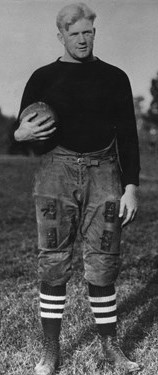 Ernie Nevers |
| So Nevers played his first season at Stanford under a head coach and an assistant who were proteges of Warner. He has been described as "almost unstoppable as a bruising running back, accomplished as a passer and punter and ferocious on defense." Nevers was also frequently out of action. Both of his ankles were severely injured, so he was able to play in parts of just two games during the regular season. By mid-December, he declared himself ready to play in the Rose Bowl. | |
53,000 fans, paying close to $200,000 for tickets, gathered on the hot (90+°) afternoon for the much-anticipated matchup. The game was broadcast by Westinghouse on all the stations of its radio network, centered at KDKA in Pittsburgh and including a Chicago station. Nevers started and played the entire game with his weak ankles so tightly taped that he had little feeling from the knees down.

1925 Rose Bowl (Stanford University Quad Yearbook Class of 1926)
The white section shown in the photo is the Stanford student section consisting of 1,100 students with different colored cards they would use to spell out words and form images during the game. The section included the 72-piece Stanford band.
Back in South Bend, spectators could follow the plays of the game on the grid-graph at the Palais Royale ballroom. "Direct Wires to the playing field will carry every single detail," proclaimed the ad for tickets, which were 50 cents apiece. The fee was "made necessary by the added cost for telegraphic service over so great a distance."
As was his habit throughout the season, Rockne started his "Shock Troops," his second stringers. The idea was to wear down the rivals until he sent in his first string. Stanford took the opening kick and ripped off three first downs before bogging down in Notre Dame territory. Murray Cuddeback's place-kick attempt from the 46 missed, but he would soon get a chance to redeem himself.
With Notre Dame taking over on its 20, Rockne inserted the "Four Horsemen and their seven corporals." Stuhldreher fumbled on the first play, and Stanford recovered on the 15. Three plays gained only 5y. So Cuddeback booted a 27y field goal. Now Rockne did what the Wisconsin and Carnegie Tech coaches had done—choose to kickoff. A piling on penalty on the runback gave the Cardinals good field position on their own 39. But with half-a-yard to go on fourth down, Stanford chose to punt, and Cuddeback's boot went over the goal line.
The Four Horsemen behind three of the "Seven Mules." RG Noble Kizer; Captain Adam Walsh at center; LG John Weibel |
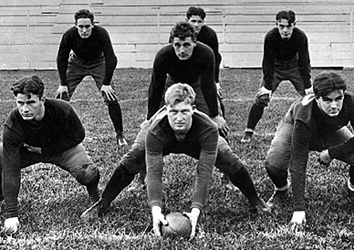 |
Even with a month of practice and with all the intelligence Warner gathered from other coaches, no team could adequately prepare for the confusing, lightning-quick Rockne offense. "Every play was something new and the combination of deceptive shift, hidden ball, effective interference and magnificent individual running was something that probably no team in the country could have solved at first sight," Stanford's Bill Henry told the Los Angeles Times after the game.
Stanford Scores First
Rockne started the game with his "shock troops" as he did for almost every game during the season. His hope was that the second team would wear down the opponent and perhaps present the ball to the first stringers in advantageous field position. But the ploy backfired.
Stanford took the opening kick and ripped off three first downs before bogging down in Notre Dame territory. Murray Cuddeback's place-kick attempt from the 46 missed, but he would soon get a chance to redeem himself.
With Notre Dame taking over on its 20, Rockne inserted the "Four Horsemen and their seven corporals." But Stuhldreher fumbled on the first play, and Stanford recovered on the 17. Three plays gained only 6y. So Cuddeback booted a 27y field goal. Stanford 3 Notre Dame 0
Now Rockne did what many coaches did in those days when they were scored on. He chose to kickoff. However, a piling on penalty on the runback gave the Cardinal good field position on their own 39. But with half-yard to go on fourth down, Stanford chose to punt, and Cuddeback's boot went over the goal line.
Starting at its 20, Notre Dame marched relentlessly into Stanford territory. The big plays were Crowley's 20y scamper around right end and plunge over left tackle for 15, and Notre Dame's first pass of the game, from Stuhldreher to Miller to the 21. Two plays later, Miller carried around left end to the nine. But after a timeout, the defense stiffened. On fourth and goal from the 11, Ted Shipkey broke through and hurried Harry's pass, which fell far from any receiver. After the play, "a doctor was called to bandage Stuhldreher's injured ankle. Cardinal boosters noted with satisfaction that Ernie Nevers' ankles
were holding out and going strong." The Notre Dame quarterback remained on the field when play resumed.
Stuhldreher: "On our last play on that drive, I got my leg twisted under me, resulting in what we thought was a bad sprain. It was taped up tightly to cut off circulation. I got along in it fairly well the rest of the game. When the tape was taken off in the dressing room, it ballooned to a size all out of proportion. Pictures later showed the outer leg bone had been broken."
Nevers ran from punt formation, but Weibel nailed him for a 3y loss. So Warner followed the common strategy of the day and ordered Cuddeback to punt out, the boot traveling only to the 32. On second down, Sleepy Jim gained 13 over tackle. On third down, Layden smashed up the middle to the 10. On fourth down, Layden dove headlong to the seven for first-and-goal as the opening period ended.


L: Ernie Nevers plunges through Notre Dame line.
R: Elmer Layden pushes over for Notre Dame touchdown.
(Stanford University Quad Yearbook Class of 1926)
Irish Dominate Second Quarter
Crowley twisted through right tackle to the three. On the next play, Layden dove through left guard to paydirt. Crowley's PAT kick was blocked by Johnston "with his brawny chest." No one suspected at the time that this would be the only offensive touchdown of the day for Rockne's machine. Notre Dame 6 Stanford 3
Warner now returned Rockne's earlier favor and elected to kickoff. The strategy paid off as the Cardinal forced a three-and-out and took over on its 20 after Layden's booming punt rolled into the end zone. Two plays netted 20. Three plays later Lawson gained 16 to the Notre Dame 39.
Layden recalled, "Nevers faded to pass, and here was where Slip Madigan's scouting bore fruit. I was playing wider than I should as a linebacker. Gus Dorais, who was sitting on the bench next to Rock, commented that I was playing out of position. 'He knows what he's doing,' Rock told Gus. Thanks to Slip Madigan, I did. Nevers tried a screen pass. Chuck Collins, our end, deflected the ball, and I caught it in mid-air. I made the catch on our 20-yard line and took off on an 80-yard sprint that made the score 12-3." Layden didn't recall that he didn't snag the interception cleanly but batted and juggled the ball before controlling it and streaking down the sidelines to the end zone. Crowley converted to make 14-3 Notre Dame.
Stanford again kicked off and forced a punt after three plays, during which LT Joe Bach left the fierce battle because of bruised ribs. He was replaced by John McMullan (6-0 204), who would play an important role in the contest. Fred Solomon ran back Stuhldreher's punt 15y to the midfield stripe.
Notre Dame alumni—most of them former players—followed Stanford during the year, charting their plays and sending the diagrams to South Bend. Rockne deciphered the X's and O's so well that he anticipated each time Stanford would try a certain sideline pass.
So the good field position led nowhere because two plays later Stuhldreher intercepted Nevers on the 38. It was the first of three Notre Dame interceptions in the game.
Harry showed Ernie how to do it, hitting Crowley for 30, but on fourth down, Stuhldreher's pass fell incomplete. Stanford took over on its 30. Not gun shy after two interceptions, the Cardinal started passing their way down the field. After several first downs, Nevers shot a pass to Solomon who dashed to the 10. But LHB James Kelly fumbled, and Walsh covered it on the 15 to end the threat as the half ended.
The heat and bruising play were taking their toll on both teams but especially the lighter boys from the midwest. "I was quite worried between halves as my men seemed all tuckered out," Rockne told the Los Angeles Times after the game. "And they frankly told me that they didn't think they could last the second half." His season-long strategy of playing two and even three strings would come in handy in the second half. Notre Dame ended up using 28 men to just 14 for Stanford.
Layden recalled: "A wooden fence enclosed the open end of the horseshoe and at half time the crowd of knothole viewers outside broke the fence down. Therefore, while the record books show a paid attendance of 53,000 for the game, you can figure we had a considerably larger group on hand for the second half."




L-R: Norman Cleaveland, Murray Cuddeback, Ted Shipkey, Fred Solomon
Stanford University Quad Yearbook Class of 1925
Irish Add to Their Lead
Notre Dame punted on its first possession, and Stanford started a march from its 24, even overcoming a 15y penalty. Cuddeback passed to Shipkey who ran to the Notre Dame 25. On 4th-and-10 Cuddeback's place-kick from the 31 sailed wide.
Layden punted on third down to set up Stanford in good shape again at midfield. Nevers hit Solomon to the 33. But Walsh and company held, forcing still another errant field goal from Cuddeback. Stanford again forced a punt but lost the momentum with another mistake. Solomon fumbled Layden's 55y boot on his 20. Huntsinger "shoved Solomon away from the ball, scooped it up and ran across a clear field for a touchdown" with the help of Collins' block of the remaining Cardinal. Crowley's goal made it 20-3.
Down 17, Warner again chose to kickoff. Considering how his defense had dominated Rockne's offense, this was a sage move, and it paid off in spades. Nevers intercepted Stuhldreher's 3rd-down pass on the 20. Three runs up the middle by Big Ernie gained a first at the 10. He pounded out three more, then another three. Two more made it fourth-and-goal at the two.
Layden recalled, "We closed in expecting another line plunge. Ernie fooled us and passed to his end, Shipkey, for a touchdown." It was actually Ed Walker who tossed to Shipkey in the end zone. Cuddeback's PAT made it 20-10.
Take away the fumble return for a touchdown, and Stanford had dominated the period, which ended several plays later without a Notre Dame first down.
Layden Strikes Again
Like most teams of that era, Notre Dame rarely threw passes when deep in its own territory. But on the second play of the fourth quarter, George Baker intercepted Crowley's pass and returned it to the ND 34. The PCC champs plowed ahead to a first down on the six. Nevers rammed through the middle to the three, but Walker failed to gain at right tackle. At that point, Rockne sent T McMullan into the game. Since, by rule, he couldn't communicate any sideline instructions until after the play, he contented himself with stopping Ernie at the one. Stuhldreher then asked him what message coach had for his beleaguered troops. "Rock said to hold 'em." And that's what they did thanks to one of the most disputed plays in Rose Bowl history.
On fourth down, Nevers tried McMullen's spot again and disappeared into the pileup. Stuhldreher recalled, "There occurred the damndest crsh of bodies I ever heard. When the ref dug everybody out, Ernie Nevers's head was over the line, but the ball was under his chest—four inches from the goal!"
Head Linesman Walter Eckersall raised his hands to signal touchdown. However, Referee Ed Thorp placed the ball inches short of the goal line. There is no doubt that when the whistle blew, the ball was short of the goal line, but Nevers and his teammates insisted the pigskin had crossed the white line but had been pushed back.
Rockne later recalled, "It was the greatest goal line stand any team of mine ever made because the toughest line-smasher in the world was coming at us."
Years later, the Four Horsemen were in Hollywood to produce a movie, "The Spirit of Notre Dame." The sports editor of the Los Angeles Herald-Express, George Davis, one of Nevers' best friends, argued with Layden, Crowley, and Miller in their dressing room during the filming. Davis said, "I still say that Nevers carried that ball over the goal line, and you pushed him back."
A small, dapper man joined the group and said, "No, he didn't." Davis turned on the intruder and declared, "I was at the end of the press box, almost directly on the goal line, with a high-powered pair of glasses. Where were you sitting?"
"On Ernie's chest," came the reply. Then sticking out his hand to Davis, the newcomer introduced himself. "I'm Harry Stuhldreher."
A small, dapper man joined the group and said, "No, he didn't." Davis turned on the intruder and declared, "I was at the end of the press box, almost directly on the goal line, with a high-powered pair of glasses. Where were you sitting?"
"On Ernie's chest," came the reply. Then sticking out his hand to Davis, the newcomer introduced himself. "I'm Harry Stuhldreher."
"Getting the ball on our one-foot line left us only one alternative," recalled Layden. "Kick it out of there and I did." The ball traveled across midfield to Solomon, who returned it to the 36. Crowley snagged Walker's long pass but came down out of bounds. Nevers passed to Shipkey for nine, then gained four more through left guard. Two plays later, Nevers broke loose up the middle to the 35. On the next play, Solomon called for Ernie to throw a pass into the right flat. But Layden intercepted on the 10.
Stuhldreher: "As a result of careful scouting, we well knew Nevers was accustomed to throw passes into the right flat. Layden backed up on his side, watching carefully for this."
But the Horsemen were again unable to gain a first down. This time Layden punted only to the 37.
Layden Deja Vu
Needing two scores with time running out, Stanford took to the air. After an incompletion, Nevers threw another interception. In a rerun of a first half play, Layden returned it 65y to paydirt. Crowley converted. The scoreboad read Notre Dame 27, Stanford 10 with 20 seconds left to play.
Stuhldreher: "Twice he (Layden) intercepted and ran the ball all the way for touchdowns. The interesting thing was that the intended receivers were taller than Elmer, and he purposely jumped and tapped the ball, basketball-like, to a spot where he would be clear to complete the interception. Another important role in these interceptions was played by Crowley. He reacted quickly on each and cleared the defensive men out of the way so Layden had a free lane."
After Layden's second interception return, Rockne removed him from the game. When Elmer reached the sidelines, he was crying.
"Why are you crying?" Rockne asked. "You just put the game on ice."
"I know why you're taking me out. You saw it!" sobbed Layden.
"Saw what?"
"I thought you saw me carry the ball in the wrong arm on that play," Layden replied.
Stanford won the statistical battle in most categories. But one important tally went Notre Dame's way and determined the victor.
--164y of offense to 134 for Notre Dame.
--17 first downs to Notre Dame's seven–all in the first half.
--Notre Dame only 3-7/48y passing compared to 12-17/146y for the Cardinal.
--Stanford had SIX turnovers–four interceptions and two fumbles. Notre Dame threw two interceptions and lost one fumble.
--17 first downs to Notre Dame's seven–all in the first half.
--Notre Dame only 3-7/48y passing compared to 12-17/146y for the Cardinal.
--Stanford had SIX turnovers–four interceptions and two fumbles. Notre Dame threw two interceptions and lost one fumble.
Nevers was valiant in defeat. He played all 60 minutes, made over 75% of Stanford's tackles, and rushed for 114y, more yardage than all the Four Horsemen combined, despite having his ankles bandaged so tightly that the circulation was almost completely shut off.
Newspapers across the land blared headlines like the one in the Alton (IL) Evening Telegraph: "NOTRE DAME BEATS STANFORD, WINS FOOTBALL TITLE."
To the end of his long career, Warner regarded the 1925 Rose Bowl as the defeat that bothered him the most. His Indians outgained the Irish 298 to 179, led in first downs 11 to 7, and in completed passes 11 to 3. "We spotted Notre Dame 21 points while they actually earned but six. Except for those errors we completely outplayed them. Notre Dame was great, but I think I had the better team."
References
Big Bowl Football: The Great Postseason Classics, Fred Russell and George Leonard (1963)
It Was a Different Game: A Nostalgic Picture of a Bygone Era, by One of the Four Horsemen of Notre Dame, Elmer Layden with Ed Snyder (1969)
The Color of Life Is Red: A History of Stanford Athletics 1892-1972, Don E. Liebendorfer (1972)
Great College Football Coaches of the Twenties and Thirties, Tim Cohane (1973)
Out of Bounds: An Anecdotal History of Notre Dame Football, Michael Bonifer and L. G. Weaver (1978)
Fighting Irish Madness: Great Eras in Notre Dame Football, Wilton Sharpe (2006)
Pop Warner: A Life on the Gridiron (Kindle), Jeffrey L. Miller (2015)
Loyal Sons: The Story of the Four Horsemen and Notre Dame Football’s 1924 Champions, Jim Lefebvre (2024)
Big Bowl Football: The Great Postseason Classics, Fred Russell and George Leonard (1963)
It Was a Different Game: A Nostalgic Picture of a Bygone Era, by One of the Four Horsemen of Notre Dame, Elmer Layden with Ed Snyder (1969)
The Color of Life Is Red: A History of Stanford Athletics 1892-1972, Don E. Liebendorfer (1972)
Great College Football Coaches of the Twenties and Thirties, Tim Cohane (1973)
Out of Bounds: An Anecdotal History of Notre Dame Football, Michael Bonifer and L. G. Weaver (1978)
Fighting Irish Madness: Great Eras in Notre Dame Football, Wilton Sharpe (2006)
Pop Warner: A Life on the Gridiron (Kindle), Jeffrey L. Miller (2015)
Loyal Sons: The Story of the Four Horsemen and Notre Dame Football’s 1924 Champions, Jim Lefebvre (2024)